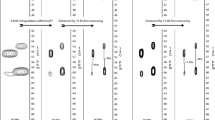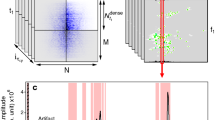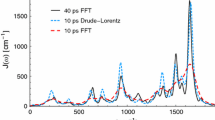Abstract
Thanks to their special spatiotemporal encoding/decoding scheme, ultrafast (UF) NMR sequences can deliver arbitrary 2D spectra following a single excitation. Regardless of their nature, these sequences have in common their tracing of a path in the \({\hbox {F}_{1}}\)–\(t_{2}\) plane, that will deliver the spectrum being sought after a 1D Fourier transformation versus \(t_{2}\). This need to simultaneously digitize two domains, tends to impose bandwidth limitations along all spectral axes. Along the \(t_{2}\)/\({\hbox {F}_{2}}\) dimension this problem is exacerbated by the fact that odd and even time points are not equispaced, and by additional artifacts such as time shifts between time points sampled while under the action of positive and negative decoding gradients. As a result, odd and even \(t_{2}\) points are typically Fourier transformed separately, halving the potential spectral width along this dimension. While this halving of the \({\hbox {F}_{2}}\) span can be overcome by an interlaced Fourier transform, this post-processing is seldom used because of its sensitivity to hardware inaccuracies requiring even finer corrections of the even/odd \(t_{2}\) data points. These corrections have so far been done manually, but are challenging to implement when dealing with low signal-to-noise ratio signals like those associated with biomolecular NMR experiments. This study introduces an algorithm for an automatic correction of all even/odd ultrafast NMR inconsistencies, based on the acquisition of a reference scan on the solvent. This algorithm was verified experimentally using an \({}^{1}\hbox {H}\)-\({}^{13}\hbox {C}\) UF-HSQC variant on ubiquitin at 600 MHz. Features of this method as well as of the interlaced Fourier transformation in general, are discussed.







Similar content being viewed by others
References
Bernstein MA, King KF, Zhou XJ (2004) Handbook of MRI pulse sequences. Academic Press, Amsterdam
Bracewell RN (1978) The Fourier transform and its applications. McGraw-Hill, New York
Bruder H, Fischer H, Reinfelder HE, Schmitt F (1992) Image reconstruction for echo planar imaging with nonequidistant k-space sampling. Magn Reson Med 23(2):311–323
Cavanagh J, Fairbrother WJ, Palmer AG III, Rance M, Skelton NJ (2007) Protein NMR spectroscopy: principles and practice, 2nd edn. Elsevier, Amsterdam
Frydman L, Scherf T, Lupulescu A (2002) The acquisition of multidimensional NMR spectra within a single scan. Proc Natl Acad Sci 99(25):15,858
Frydman L, Lupulescu A, Scherf T (2003) Principles and features of single-scan two-dimensional NMR spectroscopy. J Am Chem Soc 125(30):9204–9217
Gal M, Frydman L (2008) Ultrafast multidimensional NMR: principles and practice of single-scan methods. eMagRes. doi:10.1002/9780470034590.emrstm1024
Gal M, Frydman L (2015) Multidimensional NMR spectroscopy in a single scan. Magn Reson Chem 53(11):971–985
Giraudeau P, Frydman L (2014) Ultrafast 2D NMR: an emerging tool in analytical spectroscopy. Ann Rev Anal Chem 7:129–161
Giraudeau P, Remaud GS, Akoka S (2009) Evaluation of ultrafast 2D NMR for quantitative analysis. Anal Chem 81(1):479–484
Gudbjartsson H, Patz S (1995) The Rician distribution of noisy MRI data. Magn Reson Med 34(6):910–914
Kazimierczuk K, Orekhov VY (2011) Accelerated NMR spectroscopy by using compressed sensing. Angew Chem Int Ed 50(24):5556–5559
Krishnan VV, Murali N (2013) Radiation damping in modern NMR experiments: progress and challenges. Prog Nucl Magn Reson Spectrosc 68:41–57
Liu M, Xa Mao, Ye C, Huang H, Nicholson JK, Lindon JC (1998) Improved WATERGATE pulse sequences for solvent suppression in NMR spectroscopy. J Magn Reson 132(1):125–129
Lustig M, Donoho D, Pauly JM (2007) Sparse MRI: the application of compressed sensing for rapid MR imaging. Magn Reson Med 58(6):1182–1195
Mansfield P (1984) Spatial mapping of the chemical shift in NMR. Magn Reson Med 1(3):370–386
Metzger G, Hu X (1997) Application of interlaced Fourier transform to echo-planar spectroscopic imaging. J Magn Reson 125(1):166–170
Mishkovsky M, Frydman L (2005) Interlaced Fourier transformation of ultrafast 2D NMR data. J Magn Reson 173(2):344–350
Mishkovsky M, Frydman L (2009) Principles and progress in ultrafast multidimensional nuclear magnetic resonance. Annu Rev Phys Chem 60:429–448
Mori S, Abeygunawardana C, Johnson MO, van Zijl PC (1995) Improved sensitivity of HSQC spectra of exchanging protons at short interscan delays using a new fast HSQC (FHSQC) detection scheme that avoids water saturation. J Magn Reson Ser B 108(1):94–98
Pardo ZD, Olsen GL, Fernández-Valle ME, Frydman L, Martínez-Álvarez R, Herrera A (2012) Monitoring mechanistic details in the synthesis of pyrimidines via real-time, ultrafast multidimensional NMR spectroscopy. J Am Chem Soc 134(5):2706–2715
Pathan M, Charrier B, Tea I, Akoka S, Giraudeau P (2013) New practical tools for the implementation and use of ultrafast 2D NMR experiments. Magn Reson Chem 51(3):168–175
Pelupessy P (2003) Adiabatic single scan two-dimensional NMR spectrocopy. J Am Chem Soc 125(40):12345–12350
Piotto M, Saudek V, Sklenář V (1992) Gradient-tailored excitation for single-quantum NMR spectroscopy of aqueous solutions. J Biomol NMR 2(6):661–665
Posse S, DeCarli C, Le Bihan D (1994) Three-dimensional echo-planar MR spectroscopic imaging at short echo times in the human brain. Radiology 192(3):733–738
Posse S, Otazo R, Dager SR, Alger J (2013) MR spectroscopic imaging: principles and recent advances. J Magn Reson Imaging 37(6):1301–1325
Reeder SB, Atalar E, Faranesh AZ, McVeigh ER (1999) Referenceless interleaved echo-planar imaging. Magn Reson Med 41(1):87–94
Sattler M, Schleucher J, Griesinger C (1999) Heteronuclear multidimensional NMR experiments for the structure determination of proteins in solution employing pulsed field gradients. Prog Nucl Magn Reson Spectrosc 34(2):93–158
Schmitt F, Stehling MK, Turner R (1998) Echo-planar imaging. Springer, Berlin
Shrot Y, Frydman L (2011) Compressed sensing and the reconstruction of ultrafast 2d NMR data: principles and biomolecular applications. J Magn Reson 209(2):352–358
Tal A, Frydman L (2010) Single-scan multidimensional magnetic resonance. Prog Nucl Magn Reson Spectrosc 57(3):241–292
Wu C, Zhao M, Cai S, Lin Y, Chen Z (2010) Ultrafast 2D COSY with constant-time phase-modulated spatial encoding. J Magn Reson 204(1):82–90
Acknowledgments
This work was supported by the Kimmel Institute for Magnetic Resonance (Weizmann Institute), the Israel Science Foundation Grant 795/13, the Program of the Planning and Budgeting Committee from the Israel Science Foundation (iCORE) Project 1775/12, and the generosity of the Perlman Family Foundation.
Author information
Authors and Affiliations
Corresponding author
Electronic supplementary material
Below is the link to the electronic supplementary material.
Appendix: The interlaced Fourier transform
Appendix: The interlaced Fourier transform
As Eq. (8) used a version of the interlaced FT that has been modified from what has been reported in the literature, we devote this Appendix to justify this form as well as to introduce the behavior resulting from a peak folding into the interlaced FT-augmented spectral window from outside. We start with two signals: \(S^{(1)}\) of length M / 2 made up of the odd samples only, without extra zeros in between, and \(S^{(2)}\) also of length M / 2 made up of the even samples only. We assume the sample points of each set are separated by a duration \(\tau \) and are shifted from zero by \(\Delta _{1}\) and \(\Delta _{2}\), respectively. Thus \(S^{(1)}\) is measured at times \(\Delta _{1}+m\tau \), and similarly \(S^{(2)}\) is measured at times \(\Delta _{2}+m\tau \), where \(m=0,\ldots ,(M/2-1)\) and the time delays \(\Delta _{1}\), \(\Delta _{2}\) and \(\tau \) are precisely known. (\(\tau \), \(\Delta _{1}\) and \(\Delta _{2}\) are the generic versions of \(T_{c}\), \(\Delta t_{n}^{\mathrm {odd}}\)and \(\Delta t_{n}^{\mathrm {even}}\) in the main text.) Applying a standard FT to signals \(S^{(1)}\) and \(S^{(2)}\) results in two spectra \(\hat{S}^{(1)}\) and \(\hat{S}^{(2)}\), each with a spectral resolution of \(\delta \omega =2\pi /(\tau \cdot M/2)=4\pi /(M\tau )\) and a bandwidth of \(\delta \omega \cdot M/2=2\pi /\tau \). We assume now that the actual peaks could resonate over a range of frequencies that doubles the latter badwidth to \(4\pi /\tau \), so that the spectrum is defined by M amplitudes \(a_{m}\) with \(m=-M/2,\ldots ,(M/2-1)\). As the Fourier transforms of \(S^{(1)}\) and \(S^{(2)}\) cannot distinguish between frequencies that are \(\delta \omega \cdot M/2\) away, the transformed signals \(\hat{S}^{(1)}\) and \(\hat{S}^{(2)}\) are actually given by
where the different phase coefficients reflect the delays \(\Delta _{1}\) and \(\Delta _{2}\) defining the beginning of each set’s acquisition, and where the 1 / 2 factor is a normalization needed when compared to a FT of a full signal of length M. Solving the above two sets of equations for \(a_{m-M/2}\) and \(a_{m}\) with \(m=0,\ldots ,(M/2-1)\), we get
and
Using
the above results can also be rewritten as:
where \(m=0,\ldots ,(M/2-1)\).
Applying the 1D interlaced FT above to each of the N columns of \(S_{m,n}\) in a 2D UF experiment and making the changes
gives the expressions of Eq. (8) in the main text:
Having defined the interlaced FT, we now examine the fate of a signal which comes from outside the transform’s augmented target spectral width. Assume for this a peak with angular frequency \(\delta \omega \cdot (m+pM/2)\), where \(p=0,\pm 1,\pm 2,\ldots \). (Note that the cases \(p=0,-1\) actually cover the “allowed” spectral width already treated above.) After Fourier transforming the even and odd signals separately we get
Plugging these relations into the solution above for \(a_{m}\) and “not knowing” that the signal originates from outside the expected SW, results in
where \(a_{m+pM/2}\) is the true amplitude of the given peak. It follows from these expressions that (1) each peak outside the expected spectral width (i.e., \(p\ne 0,-1\)) splits into two folded peaks at indices m and \(m-M/2\), and (2) the magnitude of the peaks is given by a ratio of two sines, with a maximum amplification of the true peak amplitude \(a_{m+pM/2}\) by a factor of p or \(p+1\) arising when \(\Delta _{2}-\Delta _{1}=0 {\text{ or }} \tau \), but also with the possibility that this scaling value may reach zero (with the implicit assumption that \( 0\le \Delta_{2}-\Delta_{1} \le \tau \)).
Rights and permissions
About this article
Cite this article
Seginer, A., Olsen, G.L. & Frydman, L. Acquiring and processing ultrafast biomolecular 2D NMR experiments using a referenced-based correction. J Biomol NMR 66, 141–157 (2016). https://doi.org/10.1007/s10858-016-0063-8
Received:
Accepted:
Published:
Issue Date:
DOI: https://doi.org/10.1007/s10858-016-0063-8




